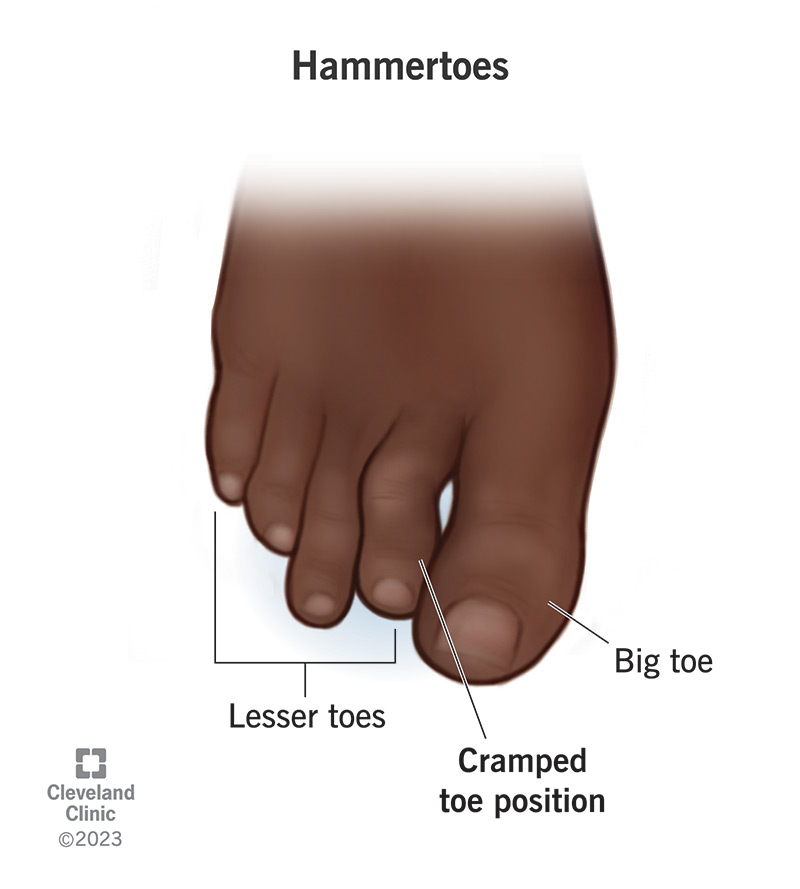Hammertoes happen when something puts pressure on your toes and pushes them out of place. Over time, muscles and tendons in your toes tighten, freezing your toes in a curled shape. A podiatrist will suggest at-home treatments to straighten your toes. Only severe cases require surgery.
Advertisement
Cleveland Clinic is a non-profit academic medical center. Advertising on our site helps support our mission. We do not endorse non-Cleveland Clinic products or services. Policy

Hammertoes are changes in your toe joints that make them point up instead of lying flat. They’re one of the most common foot issues.
Advertisement
Cleveland Clinic is a non-profit academic medical center. Advertising on our site helps support our mission. We do not endorse non-Cleveland Clinic products or services. Policy
Having hammertoes makes your affected toes look like they’re bent all the time. Specifically, a hammertoe happens when the tip of your toe points down and the middle curls up. Hammertoes usually develop in the second joint of your lesser toes (not your big toe).
A mild hammertoe may not affect your ability to walk or use your foot, but if it’s not treated, it can get bad enough to freeze your toe in its curled shape. Severe cases can make your toes look like they’re stuck in an upside-down V shape. Some people think affected toes have a hammer shape, which is where hammertoes get their name.
Visit a podiatrist if you notice any changes in your feet or toes, especially if you’re experiencing symptoms like pain, stiffness or trouble walking. They’ll suggest treatments to manage your symptoms, fix the hammertoe and help your toes return to their usual shape.
Podiatrists group hammertoes into three different types based on their severity:
Advertisement
Hammertoes are common. Experts estimate that hammertoes are up to 20% of all foot and ankle issues.
You can usually see a hammertoe. You’ll probably be able to notice one or more of your toes looking more curled than usual — especially compared to your other toes.
Other hammertoe symptoms can include:
Hammertoes happen when something pushes your toes out of position for a long time. Eventually, the muscles and tendons in your feet and toes adjust to the unusual, cramped position and tighten up. If that extra pressure lasts long enough, your muscles and tendons may tighten so much you can’t move your toes out of the curled position.
The main causes of hammertoes include:
A podiatrist will diagnose hammertoes with a physical exam of your foot and toes. They’ll examine your toes and joints. They’ll touch and move your toes to see how your joints move. Tell your podiatrist which types of shoes you wear most often, and if you notice that some kinds of footwear make symptoms like pain better or worse. Your podiatrist may ask you to stand or walk with or without your shoes on.
You may need a foot X-ray to take pictures of your foot and toe bones.
Your podiatrist will suggest treatments to relieve the pressure on your affected toes and give them room to return to their natural position, including:
Advertisement
Untreated hammertoes may become severe enough to affect your balance or how you walk (your gait). These more severe symptoms are rare, and should get better once a podiatrist diagnoses and treats the hammertoes.
Yes, most cases of hammertoes respond well to treatment. It might take several weeks after starting treatment to see any changes in your affected toes. But stick with it. Straightening a hammertoe takes time and patience. Talk to your podiatrist if it feels like your symptoms are getting worse or you’re not seeing any improvements after a few weeks.
Wearing, comfortable, well-fitting shoes is the best way to prevent hammertoes. In general, follow these tips to find comfortable shoes that fit your feet properly:
Advertisement
The term “natural” doesn’t have a set medical definition, but most people with hammertoes can treat them without surgery. Remember, there’s nothing “unnatural” about needing surgery to treat any medical condition, including hammertoes. The best treatment for you is the one that works and gets you back to your usual routine.
Most hammertoes won’t go away on their own. It’s possible that flexible or semi-rigid hammertoes will straighten out without treatment. For example, if you notice a hammertoe developing and change the kinds of shoes you wear right away, your toes may uncurl with no other treatment.
But don’t leave your foot health to chance. Visit a podiatrist or healthcare provider if you think you might have a hammertoe. A medical professional should diagnose and treat any changes in your feet, especially if you’re experiencing symptoms like pain or stiffness.
You may want to ask your healthcare provider:
All three are different conditions that affect your toes and can make them bend up. The difference is which toe joints they affect:
Advertisement
Visit a podiatrist as soon as you notice any changes in your feet, including pain and stiffness in your joints.
Hammertoes are a common issue. They happen when extra pressure on your toes forces them into a bunched-up or curled shape. Eventually, they can get stuck in that position. Wearing shoes that don’t fit well is the most common cause.
Don’t ignore changes or pain in your feet. It’s normal for your feet to feel tired every once in a while, but you shouldn’t be in pain every day. Visit a healthcare provider or podiatrist if your feet look noticeably different or hurt all the time. Your podiatrist will help you find treatments that relieve extra pressure on your toes and help straighten them out.
From sudden injuries to chronic conditions, Cleveland Clinic’s orthopaedic providers can guide you through testing, treatment and beyond.

Last reviewed on 01/12/2024.
Learn more about the Health Library and our editorial process.